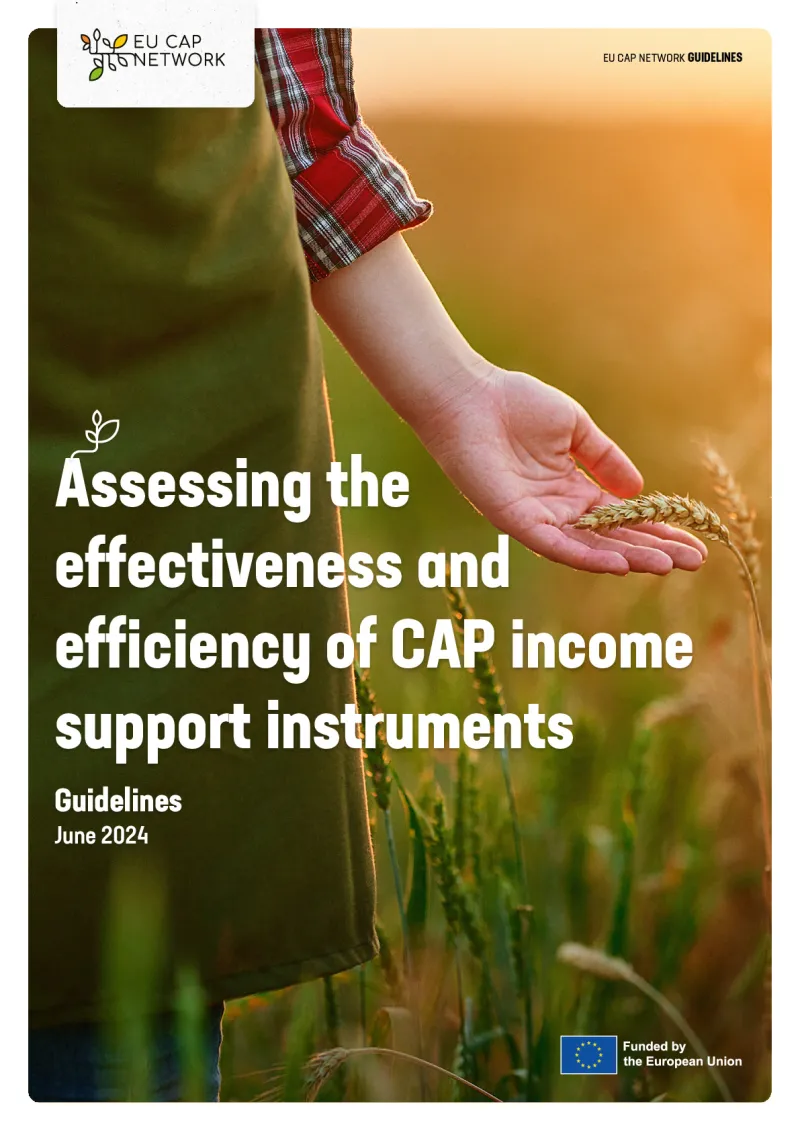Évaluation de l'efficacité et de l'efficience des instruments de soutien aux revenus de la PAC
- Évaluation
- Évaluation
- Plans stratégiques de la PAC
- Impacts socio-économiques
- Chaîne d'approvisionnement alimentaire
Les lignes directrices sur l'évaluation des instruments de soutien au revenu de la PAC proposent un cadre d'évaluation complet, comprenant des critères de jugement et des orientations techniques pour les analyses quantitatives.
- 2023-2027
- Socio-economic impacts


Les interventions de soutien au revenu de la PAC étant désormais intégrées dans les plans stratégiques relevant de la PAC des États membres pour 2023-2027, leur efficacité et leur efficience devront être évaluées, dans le cadre des exigences de l'UE concernant l'évaluation de la PAC. Pour faciliter ce processus, le Réseau européen de la PAC, soutenu par le Helpdesk européen d'évaluation de la PAC, en collaboration avec des experts universitaires, a conçu des lignes directrices méthodologiques, dans le cadre du groupe de travail thématique « Évaluation des interventions de soutien au revenu de la PAC » qui s'est déroulé d'avril 2023 à février 2024. Ces lignes directrices détaillent les méthodes d'analyse quantitative pour évaluer l'impact des interventions de soutien au revenu de la PAC sur le revenu agricole.
Diverses interventions de soutien au revenu (ISI) de la PAC, telles que : l'aide au revenu de base pour la durabilité (BISS), l'aide redistributive complémentaire pour la durabilité (CRISS), l'aide couplée au revenu (CIS), l'aide directe fournie aux zones soumises à des contraintes naturelles ou à d'autres contraintes spécifiques à la zone (ANC) et aux zones présentant des désavantages spécifiques (ASD), et l'aide couplée au revenu pour les jeunes agriculteurs (CIS YF), sont abordées dans les lignes directrices, qui offrent un cadre d'évaluation complet pour évaluer les instruments d'aide au revenu de la PAC.
Pour chaque sous-thème (niveau, volatilité et distribution des revenus), les experts des groupes thématiques de travail ont établi des critères de jugement et des indicateurs pertinents, fournissant des conseils techniques pour la réalisation d'analyses quantitatives, ainsi que des exemples pratiques sur la manière d'interpréter les résultats.
Le professeur Simone Severini de l'université de Tuscia (IT) souligne la difficulté d'évaluer l'effet net de ces interventions en raison de l'absence de scénario contrefactuel. Ainsi, les lignes directrices proposent de comparer la situation actuelle avec les aides au revenu de la PAC à un scénario hypothétique sans ces aides.
En simulant des scénarios avec et sans soutien de la PAC, en évaluant le rapport coût-efficacité et en utilisant des données provenant de sources telles que le RICA, les États membres peuvent évaluer efficacement l'impact net des interventions de soutien des revenus de la PAC sur les revenus agricoles au cours de la période de programmation 2023-2027 de la PAC.
L'une des méthodes recommandées consiste à prendre en compte l'efficacité du transfert de revenus (ITE) de l'ISI, qui reflète la part nette de l'aide transférée dans le revenu agricole, en tenant compte du manque à gagner dû, par exemple, aux coûts de transaction et/ou à l'augmentation du prix des intrants.
Une autre approche décrite dans les lignes directrices pour l'évaluation du rapport coût-efficacité consiste à examiner dans quelle mesure les résultats souhaités ont été obtenus à moindres frais. Il s'agit de comparer les effets observés sur les niveaux, la volatilité et la répartition des revenus agricoles avec les coûts de mise en œuvre de la politique.
Les lignes directrices offrent un aperçu complet des trois approches quantitatives nécessaires au calcul de l'ITE, permettant l'évaluation de la variation nette des indicateurs d'impact, comme l'exige le règlement (UE) 2021/2115. Des approches plus simples et plus avancées sont fournies, chacune ayant ses propres avantages et inconvénients.
Les États membres sont libres de réfléchir et de choisir l'approche la plus appropriée, compte tenu de leur contexte et/ou objectif spécifique.
Author(s)
EU CAP Network supported by the European Evaluation Helpdesk for the CAP